By Madeline Brashear, Sarah Diaz
Along the U.S.-Mexico border, particularly within California, Arizona, and Texas, exists one of the largest mass graves in the world, both perpetuated and ignored by the U.S. government. Since 1998, the remains of over 7,500 migrants1 have been recovered around the U.S.-Mexico border and over 7,667 are still missing.2 According to data compiled by the Missing Migrants Project, “more lives are known to be lost in the United States of America than in all other countries in the Americas combined.”3 The International Organization for Migration (IOM) has found that the Mexico-United States border is the zone of the most border deaths in the Americas, due in large part to the “harsh conditions of the arduous desert trek,” and is the third-highest zone of border deaths in the world.4 These numbers, while incredibly high, are a significant undervaluation, as thousands of migrants are reported missing each year, yet to be discovered.5 Many of these missing perished in the remote regions of the desert, their bodies will never be recovered, and their stories may never be told. An accurate calculation of the death toll will never be known.6 This brutal reality is the product of our nation’s immigration laws and policies: Border Patrol disguises the impact of its current enforcement policy by mobilizing a combination of sterilized discourse, redirected blame, and “natural” environmental processes that erase evidence of what happens in the most remote parts of southern Arizona. The goal is to render invisible the innumerable consequences this socio-political phenomenon has for the lives and bodies of undocumented people.7 In Arizona alone, the remains of approximately 3,500 migrants have been recovered since 1990. 8 Over one third of those recovered remain unidentified due to the state of decomposition in the harsh conditions of the Sonoran Desert.9 The Pima County Office of the Medical Examiner (PCOME), located in southern Arizona along the Tucson sector of the border, continues to be the agency that investigates the highest number of migrant deaths in the United States.10 While the local medical examiners work diligently to recover and identify missing migrants, the federal government does nothing to ameliorate the problem they created. It leaves that task to the border communities affected by this silent violence. For over twenty years, humanitarian organizations, NGOs, and scholars have sounded the alarm, expecting the United States government to take action to prevent the preventable.11 Instead of enacting policies to stop the deadly policies, the Department of Homeland Security (DHS) and within it, Customs and Border Patrol (CBP) have consistently enacted policies that have only amplified the problem.
CLALS Working Paper Series, No. 44 (Nov. 2023) Washington, DC: American University,
Center for Latin American & Latino Studies, 2023. 38p.















